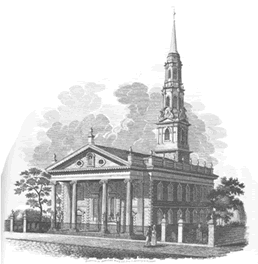

Is St. Paul's Chapel a real place? Is it still around?
St. Paul's Chapel was built in 1766 and is the oldest public building that
has been in continuous use. The Chapel, located on the corner of Broadway
and Fulton Street, was built in the Georgian Classic-Revival architectural
style and was inspired by a church in London called St. Martin-in-the-Fields.
Above is a picture of St. Paul's Chapel. You can see a picture of St.
Martin-in-the-Fields
here
. St. Paul's Chapel was very close to the World Trade Center when it was attacked
on September 11, 2001. No major damage was done to the Chapel.
Tell me about Michael "Hinky Dink" Kenna.
Michael Kenna (1857-1946) was a Chicago alderman in the First Ward from 1897
until 1923. He was called by the nick name of "Hinky Dink" because of his
slight appearance. Kenna and "Bathhouse" John Coughlin were both known as
the "Lords of the Levee". The Levee was an area in Chicago known for its
bars, brothels, and other similar dens of vice. Kenna and Coughlin took bribes
from Levee "business men" and in return protected their establishments from
police interference. The two also threw a party every year called the "First
Ward Ball". Thousands of tickets to the party were sold and waiters paid
five dollars for the opportunity to work the gala (they made their money,
plus some, back in tips). The parties were known to end in riot. You can
see a picture of Kenna
here
. You can see a picture of Kenna's grave
here
.
Now tell me about John "Bathhouse" Coughlin!
Coughlin was born in 1860 and was an alderman in Chicago's First Ward from
1893 until 1938. Coughlin got his nick name of "Bathhouse" while working in
his younger days at a Turkish Bath. Coughlin is said to have been a loud
and boisterous man, who favored loud clothes and wrote bad poetry. He, with
Kenna, took bribes from business establishments and became exceptionally wealthy
from it. You can see a picture of Coughlin
here
.
What is the Levee District?
It was an area of Chicago bordered, roughly, by 18th Street, 22nd Street,
Armour Avenue and Indiana Avenue. See a map of the area
here
. The area was known for its brothels, bars, and other dens of vice.
Ok, so Bathouse and Hinky Dink took bribes. What kind of money are we
talking about?
Massage parlors = $25/week
Bigger brothels = $50 to $100/week (plus $25 more if booze was sold)
Selling booze without a license = $50/week
Gambling = $25 per table/week
What is the Grant Memorial like?
The Grant Memorial, now called the General Grant National Memorial, was build
in 1897 and is located in New York at 122nd Street and Riverside Drive. General
Grant and his wife Julia are buried in the memorial, which is a large domed
building of granite and marble. 90,000 people from around the country submitted
the 600,000 dollars it took to create the Memorial. It remains the largest
mausoleum in North America to this day. You can see a picture of it
here
.
The Astor House sounds pretty cool.
Indeed. The hotel was opened in 1836 and was considered for many years to
be the finest hotel in the country. The building, located on Broadway (New
York City, of course), was torn down in 1926. You can see a picture of it
here
.
Tell me about Horseshoe Curve.
Horseshoe Curve was built by the Pennsylvania Rail Road and cuts through the
Allegheny mountains. The Curve was engineered by J. Edgar Thomsom and opened
on February 15, 1854. The construction of the Curve was done by hand with
hundreds of workers imported from Ireland. The Curve itself is 1800 feet
across and 2,375 feet long. You can see a picture of it
here
. Horseshoe Curve is now a National Historic Landmark.
The above information was gathered from a number of different sources. Most are noted above. A list of the others is below.
The
Everleigh Club
The
Everleigh Sisters
The
Official St. Paul's Chapel Web Site
General
Grant National Memorial
John
Coughlin
Michael
Kenna
Horseshoe
Curve
See the links section for more pertinent links, including a link to St. Martin-in-the-Fields' official site and more pictures of Grant's Tomb.